'Extraordinary' amber fossils reveal how ancient insects used colour for camouflage
The bright colours could be used as camouflage, or to help maintain body temperatures

A research team has discovered the true colours of fossilised insects, trapped in amber approximately 99 million years ago.
During that ancient period, dinosaurs including the Tyrannosaurs Rex, velociraptors, and triceratops roamed the earth.
35 amber pieces were preserved, discovered in a mine in northern Myanmar, located in south-east Asia bordering India, and China.
The set of insects discovered includes cuckoo wasps, soldier flies, and beetles.
A research team from Nanjing Institute of Geology and Palaeontology of the Chinese Academy of Sciences discovered the insects.
“The amber is mid-Cretaceous, approximately 99 million years old, dating back to the golden age of dinosaurs. It is essentially resin produced by ancient coniferous trees that grew in a tropical rainforest environment. Animals and plants trapped in the thick resin got preserved, some with life-like fidelity,” said Dr. Cai Chenyang, the associate professor who lead the study.
The wasps have a “metallic bluish-green, yellowish-green, purplish-blue or green colours on the head, thorax, abdomen, and legs” which, according to the researchers, are also the same as the cuckoo wasps which live today.
The discovery gives insight as to the lives of these insects. The cuckoo wasps, for example, lay their eggs in nests of unsuspecting bees and wasps.
It is probable that the wasps developed their colourful bodies as a means of camouflage, but it could also be that the colours played a role in thermoregulation – allowing them to maintain their core temperature.
“We have seen thousands of amber fossils but the preservation of colour in these specimens is extraordinary,” said Professor Huang Diying, co-author of the study, said.
To better understand why insects’ colours were preserved in amber fossils but not in others, the scientists cut through the exoskeleton of two amber wasps to take samples.
Using electron microscopy – which uses the tiny particles as a source of light – they were able to demonstrate that amber fossils have a “well-preserved exoskeleton nanostructure that scatters light.” The use of such small particles also means very detailed images can be captured.
In contrast to fossils which do not preserve colour, where the cuticular structures are badly damaged resulting in a dark appearance, an unaltered nanostructure of the insects implies that these colours are accurate to how they would be seen during the Cretaceous period.
Cuticles are tough, but flexible, outer coverings of an organism which provides protection, such as the white bubble at the bottom of human fingertips.
The study was published in Proceedings of the Royal Society B.
Other recently discovered fossils include the discovery of a giant sea lizard, known as ‘The Thing’, ancient hyenas which took down woolly mammoths, and flying reptiles discovered in Canadian ice.
Join our commenting forum
Join thought-provoking conversations, follow other Independent readers and see their replies
Comments
Bookmark popover
Removed from bookmarks